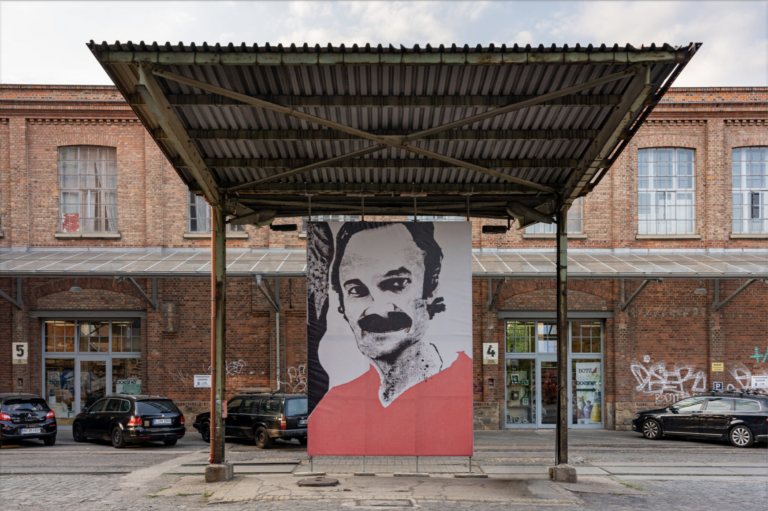RENÈ LUCKARDT, ‚Anamorphic Selfportrait‘, September 19 – October 19, 2020


Zähflüssig treiben die Konturen und Flächen des Mannes über die Bildebene. Die farbige Fläche, die das Oberteil der Person darstellt, bewegt sich wellenartig ohne sich dabei mit dem monochromen schwarz- weißen Körper zu vermischen. Der deutsch-schweizerische Künstler Rene Luckhardt (*1972) zeigt hier seine Arbeit anamorphic selfportrait. Der auf einer älteren Arbeit basierende Druck ist zwischen den zwei tragenden Säulen des Daches, welches auf der ehemaligen Baumwollspinnerei als Unterstand diente, integriert. Die Installation, die auf der kuratorischen und organisatorischen Idee Nina Mielcarczyks basiert, dehnt sich annähernd über die gesamte Höhe des Flügeldaches aus. Somit löst sich die Arbeit durch die Positionierung im Außenraum von den Konventionen eines musealen Raumes. Folglich werden die Möglichkeiten der Betrachtung ins nahezu Grenzenlose erhöht und der BetrachterIn ermöglicht, aktiv den anamorphen Zustand des Werkes zu beeinflussen. Durch das Einnehmen verschiedener Blickwinkel und Blickachsen, die das weitläufige Gelände der Baumwollspinnerei gestattet, findet eine kontinuierliche Formation des Bildmotivs statt. Je nachdem welchen Standpunkt man wählt, verliert die Darstellung des Künstlers die menschlichen Züge, abstrahiert sich selbst, mimt landschaftliche Gefüge und lässt dann wieder das Gesicht Luckhardts erkennen. Diese sogenannte Anamorphose, eine nach den Regeln der Perspektive verzerrte Darstellung, endet nicht mit der Fertigstellung des Werkes durch den Künstler, sondern wird ständig von der Änderung des Blickwinkels der BetrachterIn weiter geführt und reproduziert. Somit entsteht ein Wechselspiel aus Verschlüsselung und Entschlüsselung die das Wahrnehmen des Werkes zu einer immersiven Erfahrung macht. Durch das Zitieren seiner eigenen Arbeit stellt er die Frage nach dem Original und der Kopie und somit der Authentizität von Kunst. Einem archäologischen Prozess gleichend ergründet er das eigene Ich anhand derselben Probe in variabler Form. Er ändert in der Reproduktion seiner Arbeit nicht nur das Format, sondern auch die Technik und das Material. Das Bild, auf dem die hier gezeigte Arbeit basiert, malte Luckhardt mit Öl auf Leinwand. Diese Eigenschaften wichen einem Druck auf beständiger Werbeplane. Dieses Material greift den Ausstellungsort als Ort der ehemaligen industriellen Fertigung und Reproduktion von belastungsfähigen Stoffen auf und würdigt diesen. Auf die heutige Dominanz digitaler sozialer Medien bezogen erinnert die Arbeit an die durch Anwendung von Filtern und Masken auf Gesichter herbeigeführte Verzerrung. Die daraus entstehenden Bilder dienen somit als Projektionsfläche ständiger selbstbezogener Transformationen. Ähnlich wie die uns allzeit begleitende omnipräsenten digitalen Bilderwelten ist auch Luckhardts Arbeit nicht zu übersehen und fordert die BetrachterIn zur Auseinandersetzung mit dem Standort, der Arbeitsweise des Künstlers und den Fragen nach Original und Kopie auf und reflektiert dabei aktuelle Bildentstehungsprozesse.
The man’s outlines and patterns are floating viscously across the image surface. The coloured surface that depicts the person’s upper part moves in waves without mingling with the monochrome, black-and-white body. The Swiss-German artist Rene Luckhardt (*1972) is showing his work, anamorphic self-portrait, here. The print, based on an older work, is installed between the two supporting pillars of the roof, which used to serve as a shelter at the former Baumwollspinnerei (cotton mill). The installation, which is based on Nina Mielcarczyk’s curatorial and organisational ideas, spans across almost the entire length of the former cotton mill’s butterfly roof. By being positioned in this outside space, the work breaks away from the usual conventions of a museum space. As a result, the possibilities for looking at it are almost endless, and the viewer is enabled to actually have an influence on the anamorphic state of the work. By making use of the different angles and perspectives that the vast premises of the cotton mill allow for, we see a continuous formation of the motif. Depending on your point of view, the artist’s portrayal loses its human characteristics, it becomes abstract, mimics landscape structures until Luckardt’s face is visible again. This so-called anamorphosis, a depiction that is distorted according to the rules of perspective, does not end with the completion of the work by the artist, but it is forever continued and reproduced by the viewer’s changing perspective. The result is an interplay between encryption and decryption which turns the act of looking at the work into an immersive experience. By quoting his own work, he asks the question about the original and its copy and thus about the authenticity of art as a whole. Similar to an archaeological process, he explores his own self using the same sample in varying forms. By reproducing his work, he not only changes the format, but also the technique and the material. The painting, on which the work that is shown here is based, was painted by Luckhardt with oil on canvas. These qualities are now replaced by printing on enduring advertising banners. This material picks up on the exhibition space as a former place of industrial production and reproduction of strong fabrics and pays tribute to it. In relation to the current dominance of social media, the work is reminiscent of the distortion of faces brought about by the application of filters and masks. The resulting images thus serve as a screen for projecting constant, inward-looking transformations. Similar to the omnipresence of digital images that accompany us all the time, Luckhardt’s work cannot be overlooked and prompts the viewer to engage with the location, the artist’s working methods and the question about the original and its copy whilst also reflecting current processes of image creation.
Text: Leo Wedepohl
Translation : Katharina Volckmer